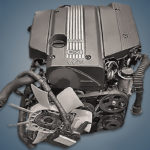The Hyundai-Kia G6DP 3.3-liter turbo engine or 3.3 T-GDi has been produced since 2015 and is installed on rear-wheel drive models of the concern, such as the Stinger or Genesis sedans. Recently, such a power unit has been actively replaced by the Smartstream 3.5 T-GDi motor.
Lambda 3.3L family: G6DB, G6DF, G6DH, G6DM, G6DP.
The engine was installed on:
- Genesis G70 1 (IK) since 2017;
- Genesis G80 1 (DH) in 2016 – 2020;
- Genesis G90 1 (HI) since 2015;
- Kia K900 2 (RJ) since 2018;
- Kia Stinger 1 (CK) since 2017.
Specifications
| Production years | since 2015 |
| Displacement, cc | 3342 |
| Fuel system | direct injection |
| Power output, hp | 365 – 375 |
| Torque output, Nm | 510 – 515 |
| Cylinder block | aluminum V6 |
| Block head | aluminum 24v |
| Cylinder bore, mm | 92 |
| Piston stroke, mm | 83.8 |
| Compression ratio | 10.0 |
| Features | DOHC |
| Hydraulic lifters | no |
| Timing drive | chain |
| Phase regulator | Dual CVVT |
| Turbocharging | two Garrett GT14s |
| Recommended engine oil | 5W-30 |
| Engine oil capacity, liter | 7.7 |
| Fuel type | petrol |
| Euro standards | EURO 5/6 |
| Fuel consumption, L/100 km (for Kia Stinger 2018) — city — highway — combined |
15.4 7.9 10.6 |
| Engine lifespan, km | ~280 000 |
| Weight, kg | 232 (with attachments) |
Disadvantages of the Hyundai G6DP engine
- This turbo engine turned out to be quite reliable and does not cause much trouble;
- The main thing is to monitor the condition of the cooling system, the unit is very afraid of overheating;
- After 200 thousand km, turbines and stretched timing chains often require attention;
- Like all direct injection engines, this one suffers from carbon deposits on the intake valves;
- And do not forget to adjust the valve clearances, since there are no hydraulic lifters here.






